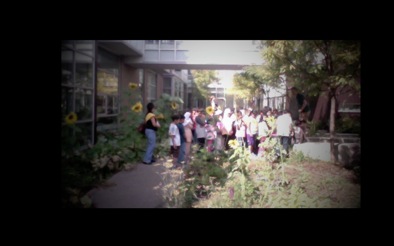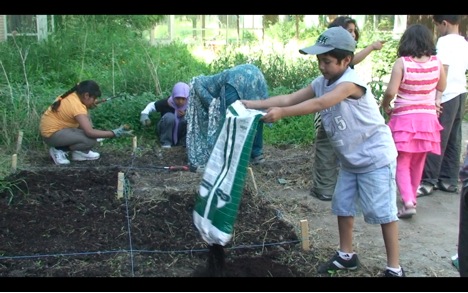 |
Educational spaces have material and symbolic dimensions that
organize students’ learning experiences and communicate what counts as
legitimate forms of knowledge and knowledge production. This article
describes the creation of a school garden, in which I, as a
university-based researcher, worked collaboratively with newcomer and
Canadian-born English language learners and their teacher at the
elementary level to connect learning meaningfully with students’ lives
(see Figure 1). The purpose of the article is to discuss how the school
garden became a pedagogical space that incorporated funds of knowledge
from the families of students, facilitated parent engagement with the
school, and produced deeper understandings about the school and
community context. The creation of the school garden built upon and
extended the rich knowledge and prior experience that the students
brought with them to the classroom, and productively connected these
resources with curriculum learning and the teacher’s instructional
practice.

Figure 1. Students in the school garden
Much scholarship relating to the education of culturally and
linguistically diverse children has focused on the benefits of linking
school-based learning with the cultural and linguistic resources
available in children’s homes and communities (e.g., Cummins &
Early, 2011; Janks & Comber, 2006; Lopez-Gopar, 2007;
Lotherington, Holland, Sotoudeh, & Zentena, 2008; Marshall
& Toohey, 2010; Stein, 2008; Stille, 2011). For instance, these
researchers have documented the role of identity affirmation in
promoting learners’ positive feelings toward and cognitive engagement
with learning. Rather than imposing the value of only school-based
knowledge, this identity-affirming instructional practice recognizes the
diversity of students’ knowledge and attests to its value in the
educational context. Building on this research, the present article
documents how pedagogy that is grounded in funds of knowledge from the
students’ home and cultural background can contribute to reshaping
curriculum knowledge across school subject areas.
PROJECT SETTING AND BACKGROUND
The garden project took place in an urban elementary school in
Canada. The school is among the largest elementary schools in North
America, serving more than 2,000 students from kindergarten to grade
five. Ninety-five percent of the students speak a language other than
English at home, and the majority of families have arrived in Canada
within the past 5 years. The project took place in a grade three class
in which the students and/or their families had come from Afghanistan,
Pakistan, Iraq, India, Kuwait, and Sri Lanka. The teacher and I settled
on a goal to explicitly draw upon students’ prior experience and
background knowledge as resources for learning. These strategies
promoted the transfer of concepts from the students’ home language(s) to
English, and created a teaching and learning context that affirmed the
students’ identities (Cummins et al., 2005). We chose to concentrate on
the social studies curriculum topic of urban and rural communities,
which provided a meaningful focus for our work and allowed us to connect
with the students’ experiences in the different communities in which
they had lived.
At the beginning of the project, the students conducted broad
research about communities. The grade three social studies curriculum
required students to demonstrate understanding of the features of urban
and rural communities, so we gathered and read books from the school
library about communities, community resources, and land use. To connect
with the students’ prior experience, we used Google Earth to view
images of urban and rural communities around the world, especially the
countries where the students and their families were from. To showcase
what they had learned, the students prepared PowerPoint presentations on
topics of their choice, such as “Overpopulation in India” and
“Traditional foods in Turkey.” We encouraged students to work with
family, friends, and/or community members to write and practice their
presentations in both their first language and English. The students
also interviewed their parents and fellow students about the school
community. They wrote interview questions such as “Where were you born?”
and “What do you like about our community?” and they recorded the
responses on a graphic organizer. The students summarized the attributes
of the school community and shared their findings with the whole class.
One of the students’ notable findings was that many families in
the community had come from rural areas and had a great deal of
experience in farming and agriculture. Because the students and their
families now lived in a cluster of high-rise apartment buildings, they
had few opportunities to draw upon these experiences in their new
Canadian home. For instance, one mother explained: “Surrounding our
house we had tea and pepper, and around our house we planted vegetables
and flowers. . . . Here we can’t grow anything.” Her daughter added: “We
can’t keep plants in our apartment.” We brainstormed ideas about how to
make a positive contribution to the school community; and we decided to
create a school garden and invite parents to assist us in this
activity.
The setting for the garden was one of several courtyards at the
school. Because of school board and union policies, caretakers could
not take care of these spaces. The caretakers had enough work
maintaining the large and overpopulated school: In addition to the
original school building, two additions had enlarged the building, and
19 portable structures held classes on space borrowed from the school
playground. As a result of this overcrowding, the school had three
staggered recess times to accommodate students on the playground
throughout the day. During recess, hundreds of children played, ran, and
kicked balls. The relatively quieter spaces were along the wall of the
school, where small groups of children stood, chatting and playing
clapping or skipping games. By contrast, the school courtyards were
unused, overgrown with weeds and littered with garbage. We set a goal of
transforming one of these courtyards into a garden in order to create a
space within the school that students and teachers could use and where
they could relate to the school environment.
CREATING THE SCHOOL GARDEN AND PARENTAL INVOLVEMENT
Gardens are often sites of collaborative work, involving shared
labor. Creating the school garden comprised several stages of
preparation and ongoing work. The teachers, the students, their parents,
and I put in long hours to prepare the ground by hand (see Figure 2).

Figure 2. Students and parents working together in the school garden
Because of school board and union policies, we were not allowed
to use any machinery to till the garden. Parents eagerly joined in day
after day, volunteering their time and enjoying the opportunity to work
with their children at school. Together we pulled weeds, added fresh
soil, and turned the earth. Parents shared their gardening skills and
promoted positive environmental behavior. Most of the parents had never
volunteered at the school, as cultural and linguistic differences had
seemed to present a barrier to their involvement with the school. In the
garden, however, expertise resided with parents. Their knowledge and
prior agricultural experiences were needed contributions to our work.
Similarly, working in the school garden provided an opening for parents
to contribute their knowledge and resources to the students’ learning.
As one father said:
Most of the kids they are not doing outdoor work, they are busy
with homework and video games, normally they are not doing any physical
things. Gardening is good for physical things; it’s good learning. If
you don’t learn anything about agriculture, you don’t understand how
farmers are making food for you, how hard it is. So this is real
learning. They [the children] know how people are making food for them.
When you get food on your table you want to take it; now [they] realize
what people are doing for them, and that they should be grateful for
that.
CONNECTING THE GARDEN TO CURRICULUM AND PEDAGOGY
Gardens are spaces of experiential curriculum and pedagogy. The
teacher used work in the garden to connect with learning outcomes
across the curriculum. Digging in the garden, sowing seeds, and watering
plants are everyday tasks that engage with broader concepts in science,
math, and social studies (Mah, 2011). For instance, the grade three
science curriculum required students to learn about the life cycle of
plants and soil composition. The garden provided unrestricted, hands-on
learning opportunities to engage with these curricular concepts. In
mathematics, the curriculum included estimating and measuring standard
units of length and using grids. We practiced these learning outcomes by
mapping the garden with stakes and string and measuring the perimeter
and area of the garden plots. Finally, with regard to the language arts
curriculum, which required students to demonstrate the ability to write
persuasive letters, the students wrote fund-raising letters to local
businesses requesting donations to support the garden project. The
students raised approximately $400 in cash and goods, which covered all
the costs of the garden; in this manner, the students not only met the
curriculum requirements but also received direct and authentic feedback
about their persuasive writing skills.
Learning in gardens and in the outdoor environment generates
knowledge that cannot be gained from textbooks. Getting dirty, we
planted the seeds that filled an unused, invisible courtyard into a
place pervaded by people, laughter, and learning. During recess time,
many of the students asked if they could spend time working in the
garden rather than playing on the playground. Kneeling in the earth and
rhythmically, deliberately weeding, planting, or turning the soil, the
children worked in silence. The students had the opportunity to
contemplate where food originates and the dedicated work required to
produce it. They reflected on their rights and responsibilities as
members of the community. For instance, one student said, “The school is
part of our community. We have to take care of our community.”
Following instructions from their parents or their teachers, the
children, through their work, felt connected to the place and space
around them. Together, as we watched the slow growth from sprouts to
plants and flowers, we came to a deeper understanding of both the
resources and needs of the community as well as the importance of
creating a space that reflected our thoughts about the kinds of places
needed for the growth and learning of children. One of the mothers
exemplifies this theme that emerged from the project:
This is a crowded area with lots of buildings. They [the kids]
need a fresh environment…. The kids are all living in apartments, so
they don’t know about gardens, plants. But we already know; in our
country we know about the environment. Here people are packed in
apartments so they don’t know about fresh air and the environment. Here
[in the garden] they will learn something about this.
CONCLUDING REMARKS: PROMOTING IDENTITIES OF COMPETENCE
Creating the garden supported productive integration of the
cultural resources that the students and their families brought with
them to school. Engaging their prior knowledge and experiences, the
students and their families were able to affirm previously invisible
topics and subject-matter knowledge as resources for school-based
learning. The garden became a material expression of the students’
diverse identities and experiences. Students and parents drew upon the
garden to produce new relationships of power, identity, and
learning―re/making the ground on which they could stand and enact their
identities in school.
The creation of the school garden drew attention not only to
what has been gained in relation to this project, but also to what has
been lost and sacrificed in current educational practice, which at times
seems to disregard the assets and resources that culturally and
linguistically diverse students bring with them to school. Families with
rural and agricultural backgrounds who immigrate to large urban centers
have few opportunities to teach their children what they know about the
land. Without access to land of their own, families face challenges in
developing their children’s understanding of their knowledge and
experience in food production and sustainability. In light of the
ecological circumstances of our present time, these families can make an
important contribution to knowledge creation and production about
environmental issues, for their own children and others.
REFERENCES
Cummins, J., Bismilla, V., Chow, P., Giampapa, F., Cohen, S.,
Leoni, L., Sandhu, P., & Sastri, P. (2005). Affirming identity
in multilingual classrooms. Educational Leadership, 63, 38-43.
Cummins, J., & Early, M. (Eds.). (2011). Identity
texts: The collaborative creation of power in multilingual schools.
Staffordshire, England: Trentham Books.
Janks, H., & Comber, B. (2006). Critical literacy
across continents. In K. Pahl & J. Roswell, (Eds.), Travel notes from the new literacy studies: Instances of
practice (pp. 96-117). Clevedon, England: Multilingual
Matters.
Lopez-Gopar, M. E. (2007). Indigenous anonymous bilingual
people: Implications for teachers. Bilingual Basics,
9(1).
Lotherington, H., Holland, M., Sotoudeh, S., & Zentena,
M. (2008). Project-based community language learning: Three narratives
of multilingual story-telling in early childhood education. Canadian Modern Language Review, 65,
125-145.
Marshall, E., & Toohey, K. (2010). Representing family:
Community funds of knowledge, bilingualism, and multimodality. Harvard Educational Review, 80, 221-288.
Mah, K. W. (2011). Young gardeners: On gardens as spaces of
experiential pedagogy. Public, 41, 98-107.
Stein, P. (2008). Multimodal pedagogies in diverse classrooms:
Representation, rights, and resources. New York, NY:
Routledge.
Stille, S. (2011). Ethical readings of student texts: Attending
to the process and production of identity in classroom-based literacy
research. Language & Literacy, 13(2),
66-79.
Acknowledgment: The author would like to thank the teachers, students, and parents involved in this project.
Saskia Stille is a PhD candidate in the Department
of Curriculum, Teaching, and Learning of the Ontario Institute for
Studies in Education at the University of Toronto. Her research focuses
on language learning in multilingual school contexts and the integration
of digital media in teaching and learning activities. |

